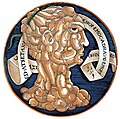Phallus: Difference between revisions
CSV import |
CSV import |
||
| Line 22: | Line 22: | ||
{{stub}} | {{stub}} | ||
<gallery> | |||
File:NAMA_Phallus_ailé.jpg|Phallus | |||
File:Tintinnabulum_Pompeii_MAN_Napoli_Inv27839.jpg|Phallus | |||
File:Osiris_statuette_cropped.jpg|Phallus | |||
File:Ithyphallic_Man_with_a_Harp,_3rd-4th_century.jpg|Phallus | |||
File:Bronze_ithyphallic_figurine_with_a_head_of_phalluses.jpg|Phallus | |||
File:0007MAN-Herma.jpg|Phallus | |||
File:The_Hindu_God_Shiva_LACMA_M.69.15.1_(2_of_3).jpg|Phallus | |||
File:Husavik_Phallusmuseum.jpg|Phallus | |||
File:Khaled_Nabi.jpg|Phallus | |||
File:Cucutenireperezentarefalica.jpg|Phallus | |||
File:Portein_wappen.svg|Phallus | |||
File:Phallic-Head_Plate,_1536.jpg|Phallus | |||
</gallery> | |||
Latest revision as of 11:53, 18 February 2025
Phallus is a term that is used in various ways across different fields such as biology, mythology, and psychoanalysis. It is derived from the Ancient Greek word φαλλός, which is primarily used to describe the penis, but has broader applications in academic discourse.
Biology[edit]
In biology, the term 'phallus' is used to describe a structure that is present in many animals. It is a part of the reproductive system and is involved in the transfer of sperm to the female during mating. The structure and function of the phallus can vary greatly between different species.
Mythology[edit]
In Ancient Greek mythology, the phallus was often depicted as a symbol of fertility and power. It was commonly featured in various forms of art and was also used in religious rituals. The phallus was also significant in other cultures and religions, including the Ancient Egyptian religion and Hinduism.
Psychoanalysis[edit]
In the field of psychoanalysis, the phallus is a key concept that was developed by Sigmund Freud and later expanded upon by Jacques Lacan. It is used to represent the idea of power and dominance in sexual relationships.












